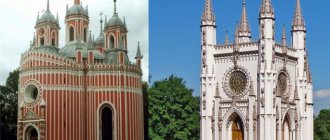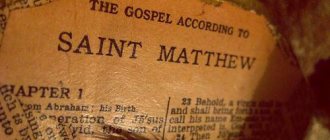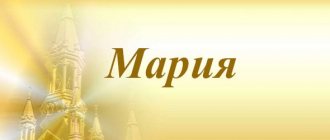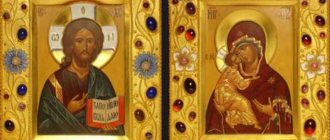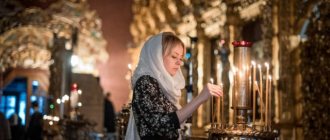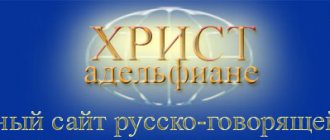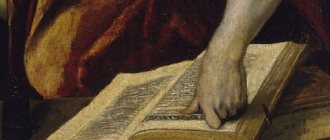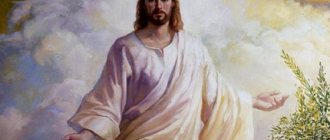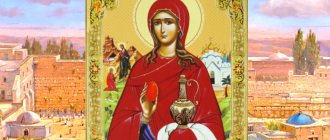| Vladimir Icon of the Mother of God. The icon is not late. XII century, Constantinople (?). Moscow St. Nicholas Church in Tolmachi at the State Tretyakov Gallery |
Theotokos (Mother of God), Most Holy Virgin Mary (Mariam), Ever-Virgin, Mother of the Lord Our God
Jesus Christ, who conceived Him without seed from the Holy Spirit, before Christmas and after Christmas Virgin. The Orthodox Church believes that the first word about the Most Holy Theotokos was spoken in heaven. It was said by God himself in the promise about the tempter of our fallen ancestors. This promise, called the “First Gospel” by the expositors of Holy Scripture, is found in the words of God addressed to the seducing serpent: “I will put enmity between you and the woman, and between your seed and her seed: it will bruise your head, and you You will bruise his heel” (Genesis 3:15). Since in the form of the serpent hid “the great dragon, the ancient serpent, called the devil” (Rev. 12:9), then by wife we must mean here not Eve proper and not any other ordinary wife - especially since Eve’s descendants up to the very The coming of the Lord Jesus Christ into the world did not have much success in the fight against the spiritual serpent. “God speaks to the serpent,” notes St. Epiphanius, “I will put enmity between you and the woman, between your seed and her seed; but such seed of a woman is nowhere to be found; Therefore, the enmity towards Eve that the serpent and the envious person who was in the serpent, the devil, will lead to her offspring is only speculative.” Who is this woman who corrects Eve's sin? St. John of Damascus says: “Eve became the first criminal, and through her, who served as the instrument of the fall of the progenitor, death entered the world; but Mary, submissive to the will of God, introduced immortality into the world.” The wife of whom God speaks is the Most Pure Virgin Mary, blessed and blessed, through whom the Word became flesh through the influx of the Holy Spirit and the power of the Most High. The seed of the woman, who triumphed over the dark forces, abolished the deadly devil, destroyed his works and, with her suffering, death and resurrection, crushed the very head of the seducing serpent, is the Savior of the world - the Lord Jesus Christ. Subsequently, this promise of God, reverently preserved in humanity, was developed and clarified by the prophets. Of course, the main focus of prophetic omens was the Lord Jesus Christ, but since His Most Pure Mother also served the cause of saving people, there are prophecies about Her in the Holy Scriptures, set forth together with predictions about the Savior. The best and most reliable explainers of these prophecies are the Holy Fathers and Teachers of the Church.
In the New Testament, the name of the Mother of God is mentioned several times in Matt. 1, 16, 18-25, Matt. 13, 55, Mark. 3, 31-32, Luke. 1, 26-56, Luke. 2, 1-40, 48, John. 19, 25-27, Acts. 1, 12-14, but from this source we have only very little information about Her life, since the evangelists had the first and main task of telling about the earthly life and deeds of Jesus Christ.
The lack of information about the life of the Mother of God that we receive from the Holy Scriptures is abundantly compensated by many traditions, some of which have an undoubted stamp of deep antiquity and, in any case, reflect the faith of Christian society since ancient times.
The church historian Nicephorus Callistus preserved the legend about the appearance of the Blessed Virgin Mary. She was of average or slightly above average height; the hair is golden, the eyes are quick, olive-colored, the eyebrows are arched and blackish, the nose is oblong, the lips are blooming, the face is not round and not sharp, but somewhat oblong, the arms and fingers are long. When talking with others, She remained calm, did not laugh, was not indignant, and was not angry. As for Her clothing, She was content with the natural color of the fabric. In all Her actions a special grace was revealed.
As St. Gregory of Neocaesarea, in the Most Pure Virgin we are amazed not only by Her immaculate and pure bodily beauty, but also by the perfection of Her soul. And how could it be otherwise, if the entire treasure of grace is concentrated in Her face? Her clothes are modest, alien to luxury, her step is sedate, firm, her look is stern, but pleasant, her speech is meek. Her mind is subordinated only to God and directed towards Him. She hates only sin. Her thoughts are beneficial to the soul, free from everything unnecessary and harmful to the soul. Her eyes are always turned to the Lord, Her ears are tuned to listen to the word of God, Her lips glorify the Lord and discuss the word of God, Her heart is pure and immaculate. All of It is the palace of the Spirit, the city of the living God.
St. Dionysius the Areopagite, who was privileged to see the Most Holy Virgin in Jerusalem three years after his conversion to Christianity, describes his feelings at this meeting: “When I appeared before the godlike, most luminous Virgin, I was illuminated from without and within by such a great and immeasurable divine light and Such a wonderful fragrance of various aromas spread around me that neither my body nor my spirit was able to endure such great and abundant signs and manifestations of eternal bliss and glory. My heart is faint, my spirit is faint from Her glory and divine grace! The human mind cannot imagine any glory or honor higher than the bliss that I, unworthy, then tasted.”
“Who can imagine,” said Emperor Leo the Philosopher in his homily on the Dormition of the Most Holy Theotokos, “what glory she has now received from her Son? God crowns different saints with glory in different ways, according to the word of the apostle; “There is another glory of the sun, another glory of the moon, another of the stars; and star differs from star in glory” (1 Cor. 15:41). But the Most Pure Mother received the glory of the sun... and the glory of the moon, and the glory of the stars... She has a crown better than all the holy virgins, because with her purity She surpassed the angels... She has the crown of martyrs: standing at the cross... She suffered more than all the martyrs... She has the crown of the prophets, because she truly predicted that all generations would please Her (cf. Luke 1:48). She has the crown of the evangelists, because She is, as it were, the book of the hypostatic Word. It has the crown of the apostles: if the apostle boasts: “Have I not seen Jesus Christ our Lord?” (1 Cor. 9:1), then who saw Him more clearly than the Most Holy Mother? She has the crown of confessors, for she firmly confessed “My soul magnifies the Lord... He who is mighty has done great things for me” (Luke 1:46, 49). She has the crown of the humble, because she said about herself: “He looked upon the lowliness of His servant” (Luke 1:48). She has the crown of the venerables: Her Dormition before the Lord was awarded greater glory than the death of all the venerables. She has the crown of fasters, because she has subordinated the body to her spirit. She has the crown of mercy: the Holy Church prays to Her as the source of mercies: “Open the doors of mercy to us!” She has the crown of unmercenaries, for she gave birth to the One who gave the power of healing and said: “Give and it will be given to you” (Luke 6:38), and she herself gives grace to those who ask. She, finally, has a greater crown than all the saints, because all the saints stand before the throne of God with fear, and She - with maternal boldness, for the Mother’s prayer addressed to the mercy of the Lord can achieve much.”
| The Virgin Mary with the Child Jesus. Fresco approx. 225 Ceiling of the catacombs of St. Priscilla in Rome. |
The dogmatic teaching on the veneration of the Mother of God was developed gradually, as was the case with other dogmas.
Wrong opinions, false teachings and heresies forced church teachers to more accurately and definitely present the general church teaching about the veneration of the Mother of God at the same time as there were disputes about the person of Jesus Christ. The outcome of the Nestorian dispute had a decisive influence on the definition of the doctrine of the veneration of the Mother of God, after which the name “Theotokos”, found even in St. Athanasius the Great, was recognized by everyone and became commonly used. The teaching of the Orthodox Church about the Blessed Virgin Mary contains the following main provisions: The Blessed Virgin Mary is
- in the proper sense of the word - the Mother of the Lord Jesus Christ and therefore the Mother of God
- Ever-Virgin, that is, before Christmas, at Christmas and after the birth of the Lord - Virgo
- The highest of all heavenly powers and saints
- Our first intercessor and helper before God.
Veneration of the Mother of God in Rus' and in Christian denominations
On Russian soil, the veneration of the Mother of God acquired special significance, which was expressed, in particular, in the establishment of the Feast of the Intercession of the Most Holy Theotokos (October 14), unknown to the rest of the Christian world, and in the nationwide glorification of the Mother of God icons.
For comparison, it should be noted that in Protestantism there is practically no theological and mystical understanding of the meaning of the personality of the Mother of God and Her prayerful glorification. The forms of Catholic piety in relation to the Virgin Mary from the Orthodox point of view seem overly sensual and naturalistic.
For example, the Catholic naming of the Mother of God as the Glory of God, the Holy Rose in the sense of a certain paradise flower, a symbol of purity and purity, is organically alien to Orthodoxy. In addition, in the Catholic tradition, the dignity of the Mother of God is downplayed by the dogma of Her Immaculate Conception. According to this dogma, adopted in 1854, the Mother of God was conceived supernaturally, i.e. providentially removed from the composition of humanity and even before her birth freed from the power of original sin. The Orthodox Church views this dogma as a derogation of the moral perfection and personal feat of the Mother of God.
Features of worship
At the all-night vigil during the polyeleos, the clergy bring out the Shroud. This represents the coffin with the body of the Most Pure One. It is placed in the middle of the temple. Anointing with holy oil takes place before her. Then all parishioners venerate the Shroud. Before kissing, you need to make two prostrations, and after - one.
According to custom, after the all-night vigil, the Burial of the Mother of God is served . This symbolizes the burial of Her body. At the same time, the clergy take out the Shroud and carry it around the temple, making a religious procession. At the same time they sing the Trisagion for the dead. At the all-night vigil the Most Honest One is not sung, but instead special chants are sung for the ninth song of the canon. The troparion, kontakion, luminaries, stichera and magnification of this holiday are especially touching.
Proteor Andrei Tkachev on the Dormition of the Blessed Virgin Mary
Why are there so many miraculous icons of the Mother of God?
Great is the help and intercession of the Blessed Virgin in the life of the Church. Miraculous icons reflect this reality, recording these facts. The icons reflect the reality of the Mother of God’s care for Christians who prayerfully turn to Her.
Celebrating the memory of a particular icon, we remember the event corresponding to its writing and glorify the Most Pure Mother of our Savior. As you know, glorifying the saints is a form of glorifying God, because He is the source of holiness, “Be holy, for I am holy” (Lev. 11:44-45).
List of miraculous icons of the Mother of God.
The earthly death of the Blessed Virgin Mary
Just before her death, the Most Pure One asked God to have all the apostles present at the time of Her death. At that time they were in different parts of the world, preaching the Christian faith. Her prayer was fulfilled: at God's command, all the apostles were miraculously transferred by Angels to Her bed.
The Most Holy Theotokos was praying, and suddenly there was a noise. in full view of everyone and took His Mother with Him . On all icons, Her soul in the hands of Christ is depicted in the form of a baby. This was a joyful event for the Most Pure One, the end of Her earthly torment. Finally, She can again always see Her Son and be close to Him. Therefore, this event is considered a holiday in the Church, and not a day of sorrow. We all rejoice together with the Most Pure One, calling this holiday not death, but “dormition,” which translated means “sleep.” She simply fell asleep in the flesh, without torment, and quietly gave Her Most Pure soul to Her Son.
Misunderstanding before burial
The apostles took the bed with the body of the Most Holy Theotokos and solemnly, singing psalms, carried it to the burial place. In front they carried a branch from the Garden of Eden, which the Archangel brought to Her. But then a misunderstanding happened. Some wicked person wanted to ruin this holiday. He approached the tomb of the Virgin Mary and touched it, wanting to knock it over. But then an angel appeared and cut off the hands of the sinner. The unfortunate man began to cry out to the Mother of God, begging for mercy. The Most Pure One, of course, forgave him and healed him.
The arrival of the Apostle Thomas and the miracle that took place
The body of the Blessed Virgin was placed in the Cave of Gethsemane , covered with a stone according to Jewish custom. Here, by the providence of God, the Apostle Thomas arrived. He was not present at the death of the Most Holy Theotokos with the other apostles. He was very upset that he did not have time to say goodbye to Her. Thomas begged to open the cave especially for him.
And then a miracle happened: when they rolled away the stone from the cave, it turned out to be empty. There was no body of the Most Pure Mother of God in it. Christ did not want to consign the body of His Mother to decay and took Her to heaven along with the body.
About the prayerful appeal to the Mother of God “save us!”
A prayerful appeal to the Most Holy Theotokos “save us” can mean a request for deliverance or protection from danger. Danger can mean various threats. Firstly, the dangers can be of a religious nature: the danger of not fulfilling some norm of God’s law, the danger in the fight against the forces of evil, and finally, the danger of evading life in Christ.
Secondly, dangers can mean threats that are not directly related to Christian activity. Responding to our prayers, the Mother of God, as the Immaculate Mother of Christ, can help us through intercession, or she can demonstrate Her power and authority as the Heavenly Queen, for example, by sending angels to help the person praying.
Thirdly, due to Her profound deification and obvious certainty as the Intercessor for the human race before Her son Jesus Christ, we can turn to the Mother of God for the salvation of our soul, but having the correct idea that She achieved this not by nature, but by grace, participation in God.
Fourthly, this is not the only form of prayer appeal to the Mother of God for intercession, for example, the following are also used: “Pray to Thy Son and our God,” [Christ] pray for our souls, “... Having given birth to the True God. Pray to him for the salvation of our souls.”
Mary in the New Testament
Mary, mother of Jesus Christ and her role in the New Testament
- angel's announcement of the birth of Jesus => Luke 1:26-38
- visited cousin Elizabeth => Luke 1:39,40
- She magnified the Lord with song => Luke 1:46-55
- An angel of the Lord appeared to Joseph => Matthew 1:18-25
- gave birth to Jesus in Bethlehem => Luke 2:1-7
- introduced Jesus into the temple => Luke 2:21-24
- fled with Joseph and the child to Egypt => Matthew 2:13-15
- returned and settled in Nazareth => Matthew 2:19-23
- with twelve year old Jesus in the temple => Luke 2:41-52
- had other children => Mark 6:3
- was at the wedding in Cana => John 2:1-5
- asked about Jesus' health => Mark 3:21
- saw the crucifixion of Jesus => Matthew 27:55,56
- at the cross her care was entrusted to John => John 19:25-27
- among the disciples after the Ascension => Acts 1:14
What is the “immaculate conception of the Virgin Mary”?
The Catholic doctrine of the immaculate conception of the Virgin Mary, or, what is the same thing, that She was supernaturally delivered from the bonds of original sin “from the very first moment of Her Conception,” spread (in the Western Church) during the late Middle Ages, but was only dogmatized in the middle of the 19th century (by Pope Pius IX, in 1854).
The Orthodox Church, while highly appreciating the virtues of the Mother of God, nevertheless never taught that She was originally free from original sin. In patristic theology there is a clear statement that the Virgin Mary was purified by the Holy Spirit during the Annunciation, just before the conception of the Lord Jesus Christ (but not at the moment of Her conception from Joachim and Anna). In relation to the Savior, it is not customary to use the expression “immaculate conception,” but it is accepted: “semless conception from the Holy Spirit.”
It should be noted that regarding the question of the time of the purification of the Mother of God from original sin, there are different opinions in Orthodox theological literature. According to some, Her pre-purification by the Holy Spirit (before the conception of the Messiah) was also associated with Her cleansing from original damage; according to others, the Mother of God was cleansed from original sin at the moment of the Descent of the Holy Spirit on the Apostles on the Day of Pentecost; finally, others believe that Her washing from the filth of original sin occurred through Her acceptance of Baptism (performed by the Evangelist John the Theologian). These disagreements should be classified as private theological opinions.
Virgin MaryHoly Mother of God
Earthly mother of Jesus Christ. One of the most revered personalities and the greatest of Christian saints. Archangel Gabriel appeared to her and announced that, according to divine choice, she would become the mother of Jesus, the Son of God. According to the canonical Gospel, she was also present at the crucifixion of Christ. At the end of her earthly life, her body went to heaven.
Mary was born in the 1st century BC. in the city of Nazareth, Israel. Father, Joachim, is a believing and righteous man. A mother named Anna, like her husband, always followed the letter of God's Law. This family lived in complete harmony, only one thing darkened the existence of the spouses: the absence of children. For many years they prayed that God would send them a child, but their prayers were in vain.
We had been married for almost fifty years and were already desperate to have a child. But one day Anna, walking through the garden, saw an angel. He promised the surprised woman that he would soon become a mother, and her child would be known to the whole world. She hurried home to tell her husband about the vision. Imagine her surprise when it turned out that Joachim had also seen an angel who announced that the prayers for the child had been answered.
The couple raised their daughter and were preparing to fulfill their promise. Three years later, little Maria was sent to be raised in the Jerusalem temple. Surprisingly, the girl easily climbed the fifteen steps to the temple gates, which were sometimes difficult for adults too.
A few years later, the righteous Anna and Joachim died. Maria continued to live at the temple, studying together with other girls in a special school. Here, young pupils were taught the basics of science, taught the Word of God, and also prepared for worldly life, housekeeping and raising children. The girl was best at sewing. There is a legend that it was she who was entrusted with sewing the curtain and bedspread for the temple sanctuary.
Given such an upbringing, Mary should have grown into an enviable bride - hardworking, pious and educated. But such a fate did not attract the girl, and she took a vow of celibacy. This created certain difficulties: mature girls were not allowed to live at the temple, and the grown-up Mary had to leave God’s house.
But according to the laws of that time, she was not allowed to live alone. The clergy, who became attached to their pupil, found a way out: twelve-year-old Mary was given to the elderly widower Joseph, who, due to his age, must preserve the girl’s purity, allowing her not to break her word given to God.
At first, the old man was not happy about the young bride who fell on his head. In addition, the man was afraid of gossip behind his back and ridicule of relatives and neighbors - the age difference was so great. However, he did not dare to contradict the will of the priests and took the girl into the house, calling him his wife.
After some time, Joseph, who worked as a carpenter, left home for several months, going to another construction site. Maria, remaining on the farm, looked after order, weaved and prayed a lot. According to legend, while she was praying, an angel appeared to the girl and told her about the imminent birth of her son.
The boy, according to the angel, was destined to become the savior of people, the one whose coming the Jews had long awaited. Mary was embarrassed by this revelation, because she remained a virgin. To which she received the answer that she would suffer from a higher power, and not from the male seed. This day in the Christian tradition has become the Feast of the Annunciation - in memory of the good news that the Virgin Mary received.
And indeed, Maria soon realized that she was pregnant. The woman did not yet realize the role that her son had to play, but she understood that she had become a participant in a real miracle of the immaculate conception.
Joseph, who returned home after some time, immediately noticed the changes that had occurred in his wife. This kind man did not immediately believe Maria’s story, deciding that the naive girl had simply become a victim of deception by some neighbor’s young man who had seduced her.
The old man did not blame his wife and even wanted to secretly allow her to leave the city so that she would not become a victim of justice: treason in those days was severely punished, an unfaithful woman could be stoned and whipped. Then an angel appeared to the carpenter, telling him about the immaculate conception of Mary. This convinced Joseph of his wife’s innocence, and he allowed the girl to stay.
Shortly before the due date, Caesar Augustus announced a general population census. To do this, people had to come to Bethlehem on their own. Joseph and Mary set off on their journey. Arriving at the place, we found that the city was simply overcrowded with crowds of people. It was not possible to find a place to stay for the night, and the couple decided to spend the night in a cave in which the shepherds hid their cattle from the rains.
It was there that Mary gave birth to a son. The boy's first cradle was a manger for feeding animals. That same night, the star of Bethlehem shone above the cave, the light of which told people about the appearance of a miracle on earth. In addition, the light of the star was seen by the Magi, who immediately set off on their journey to personally worship the newborn Son of God and present him with gifts.
Seven days later, as required by the law of the time, the baby was circumcised and given a name. The son of the Virgin Mary was named Jesus. Then the boy was brought to the church to present him to God and make the traditional sacrifice. A certain elder Simeon, who also came to the temple that day, blessed the baby, realizing who was in front of him. The girl allegorically hinted that both she and her son were destined for a difficult fate.
While the Holy Virgin Mary was in Bethlehem with her husband and newborn baby, the cruel and ambitious King Herod learned about the birth of the Son of God. However, the predictors who told about the miracle that happened could not answer the question into whose family Jesus was born.
Then, without hesitation, the king ordered the destruction of all the newborns that were in Bethlehem. Joseph was warned about the impending trouble by an angel who again appeared to the elder in a dream. Then the carpenter took refuge in Egypt with Mary and the baby, and only when the danger had passed did he return with his family to his native Nazareth.
Mary accompanied Jesus Christ everywhere, supporting him and helping him bring the Word of God to people. The woman was also present at the miracle performed by Jesus, who turned water into wine. The Mother of God had a hard time: the constant sermons that her son preached did not always evoke a good response in people. Often I had to endure ridicule and aggression from those who did not want to accept the tenets of religion.
On the day when Jesus Christ was crucified by the executioners of Pontius Pilate, Mary felt the pain of her son and even fainted when the nails pierced his palms. And although the Mother of God knew from the very beginning that he was destined to accept torment for the sins of people, his mother’s heart could hardly withstand such suffering.
According to legend, the Mother of God was present at the Ascension of the Lord. After this, she remained in Jerusalem along with other disciples of Christ, awaiting the promised descent of the Holy Spirit. Mary participated in the distribution of lands by lot among the apostles, to which they were to go to preach. Georgia fell to her, but, at the command of Jesus Christ, Apostle Andrew went there.
Mary spent the rest of her life on Athos, preaching among the pagans and carrying the Word of God. The Mother of God spent all her days in prayer, asking her son to take her to him. One day, an angel appeared to the woman again, announcing that her prayers had been heard, and after three days her wish would be fulfilled.
On the appointed day in 48 , Mary, lying on her deathbed, humbly awaited her fate. People close to her gathered around her. They all witnessed a new miracle: Jesus Christ himself descended from heaven to take his mother with him. The soul of the Mother of God left the body and ascended into the Kingdom of God. The body that remained on the bed seemed to glow with grace.
Some time later, the apostles discovered that the body of the Virgin Mary had disappeared from the burial cave. On the same day, the Mother of God appeared to them and announced that her body had been ascended to heaven following her soul, so that she could become a Holy Intercessor before God for people in need of help.
Memory of the Virgin Mary
Memory of the Virgin Mary
In the Orthodox Church, the Nativity of the Blessed Virgin Mary - September 21 Entry into the Temple of the Blessed Virgin Mary - December 4 Annunciation of the Blessed Virgin Mary - April 7 Dormition of the Blessed Virgin Mary - August 28 Memory of the Righteous Saints Joachim and Anna, parents of the Mother of God - September 22 Conception of the Righteous Anna of the Blessed Virgin Mary - December 22 Council The Most Holy Theotokos - January 8 The Protection of the Most Holy Theotokos - October 14 The position of the honorable robe of the Most Holy Theotokos in Blachernae - July 15 The position of the belt of the Most Holy Theotokos in Chalcopratia - September 13 The Praise of the Most Holy Theotokos (Saturday Akathist), in memory of the miraculous defense of Constantinople from the Avars and Persians in 621 year, 5th Saturday of Great Lent Renovation of the Church of the Most Holy Theotokos at the Life-Giving Spring in Constantinople, the day of the consecration of the cathedral, in which the Mother of God, according to legend, performed a number of miracles, Friday of Bright Week
In the Catholic Church January 1 - Solemnity of the Blessed Virgin Mary February 2 - Presentation (Purification of Mary) February 11 - Feast of Our Lady of Lourdes March 25 - Annunciation May 13 - Feast of Our Lady of Fatima May 31 - Visit of Mary to Elizabeth August 15 - Assumption (Assumption of Our Lady) 8 September - Nativity of the Virgin Mary September 15 - Feast of Our Lady of Sorrows October 7 - Feast of Our Lady of the Rosary November 21 - Entry into the Temple December 8 - Immaculate Conception of the Virgin Mary December 12 - Feast of Our Lady of Guadalupe
Temples of the Blessed Virgin Mary
Temples of the Blessed Virgin Mary
Catholic Church of the Blessed Virgin Mary (Vladivostok) Church of the Immaculate Heart of the Blessed Virgin Mary (Kemerovo) Church of the Intercession of the Blessed Virgin Mary in Krasnoye Selo Church of the Intercession of the Blessed Virgin Mary on Lyshchikova Mountain Church of the Blessed Virgin Mary of Carmel (Gatchina) Cathedral of the Intercession of the Blessed Virgin Mary (Mineralnye Vody) Cathedral of the Assumption of the Blessed Virgin Mary Mary (St. Petersburg) Assumption Church (Alikovo) Temple of Our Lady of Perpetual Help (Petrozavodsk) Temple of Our Lady of Loreto (Orenburg) Temple of Our Lady of Lourdes (St. Petersburg) Church of the Intercession of the Blessed Virgin Mary (Malaya Gribanovka) Church of the Intercession of the Blessed Virgin Mary in Rubtsovo Temple Astrakhan (Astrakhan) Temple of the Assumption of the Blessed Virgin Mary (Bogoroditsk) Temple of the Assumption of the Blessed Virgin Mary in Arkhangelsk-Tyurikov Temple of the Assumption of the Blessed Virgin Mary on Uspensky Vrazhek Church of the Nativity of the Blessed Virgin Mary (Raskildino) Church of the Assumption of the Blessed Virgin Mary (Apatity) Church of the Assumption of the Blessed Virgin Mary on PokrovkaChurch of the Virgin Mary (Gdansk) ) Church of Our Lady of Loreto Church of the Virgin Mary (Nuremberg) Church of the Virgin Mary (Saidabad) Church of the Virgin Mary (Zwickau) Church of the Blessed Virgin Mary (Chennai) Church of the Blessed Virgin Mary of Mount Carmel (Beijing) Church of the Blessed Virgin Mary of Heaven (Shanghai) Church of the Assumption Church of the Blessed Virgin Mary (Krakow) Church of the Blessed Virgin Mary Queen of Angels (Singapore) Church of the Blessed Virgin Mary of Carmel (Gatchina) Church of the Assumption of the Virgin Mary (Bridge) Cathedral of the Nativity of the Blessed Virgin Mary (Košice) Church of the Blessed Virgin Mary of Lourdes (Shanghai) Church of the Immaculate Conception of the Blessed Virgin Mary Mary (Baku) Church of the Immaculate Conception of the Virgin Mary (Dusseldorf) Church of the Nativity of the Blessed Virgin Mary (Singapore) Cathedral of the Virgin Mary (Augsburg) Cathedral of the Virgin Mary (Minsk) Szeged Cathedral Cathedral of the Virgin Mary (Sydney) Cathedral of the Virgin Mary (Konstanz) Cathedral of St. Mary (Sibiu) Cathedral of the Holy Virgin Mary (Limerick) Santa Maria de Vitoria (Spain) Toledo Cathedral St. Mary's Church (Berlin) St. Mary's Church (Brussels) St. Mary's Church in Wurzburg St. Mary's Church (Dortmund) St. Mary's Church (Cairo) ) St. Mary's Church (Kaiserslautern) St. Mary's Church (Lübeck) St. Mary's Church (Mühlhausen) St. Mary's Church (Oslo) St. Mary's Church (Widnes) St. Mary's Church (Chennai) St. Mary's Church (Stralsund) St. Mary's Church (Celle) Finnish Church of St. Mary (St. Petersburg) St. Mary's Church (Krakow) Basilica of the Blessed Virgin Mary, Queen of Poland (Lichen)
The Blessed Virgin Mary in culture
The Blessed Virgin Mary in culture
Painting
Giovanni Bellini Madonnas Raphael Madonnas Black Madonna Altarpiece of Barbadori Altarpiece of Merode Altarpiece of Noviziato Altarpiece of St. Mary Annunciation (painting by Leonardo da Vinci) Annunciation (painting by Filippino Lippi) Annunciation (painting by Jan van Eyck) Annunciation (San Marco, Fra Angelico) Annunciation with St. Emidius Virgin and Child (Vrubel) Assumption of Mary (painting by Guercino) Darmstadt Madonna Virgin Mary in the house of St. John of Disputus Dresden triptych Epiphany (drawing by Michelangelo) Madonna of Solothurn Coronation of Our Lady (painting by Giambono) Coronation of Our Lady (painting by Monaco) Cross with a crucifixion Madonna Magnificat Madonna (painting by Munch) Madonna Ansidei Madonna Araceli Benois Madonna Madonna in the Arbor of Roses Madonna in the Armchair Madonna in the Rose Garden (painting by Luini) Madonna of the Rocks Madonna in the Church Madonna in Glory (painting by Fiorentino) Madonna in Glory with Seraphim Madonna of Mount Carmel with Souls in purgatory Madonna della Loggia (painting) Madonna di Loreto Madonna di Sant'Alessio Madonna Doni Madonna and Child with an Angel Madonna of Casale Madonna from the Annunciation scene Madonna of Canon van der Paele Madonna of the Chancellor Rolena Madonna Castelfranco Madonna Litta Madonna of the Meadow Madonna Ognissanti Madonna of the Port -Lligata (first version) Madonna with an orange tree Madonna with a spindle Madonna with a carnation Madonna with a long neck Madonna and Child (painting by Lo Spagna) Madonna and Child (painting by Lorenzetti, Brera) Madonna and Child (painting by Lorenzo Gerini) Madonna and Child (painting Masters of female half-figures) Madonna and Child (painting by Provost) Madonna and Child (painting by Fungai) Madonna and Child and Two Angels Madonna and Child and Saints (painting by Montagna) Madonna and Child and Four Angels (painting by Fra Bartolomeo) Madonna and Child and Four Angels (painting by Fra Beato Angelico) Madonna and Child under an apple tree Madonna and Child, Saint Catherine and Saint James Madonna and Child, Holy Bishop, John the Baptist and angels Madonna and Child, Saint James the Younger, John the Baptist and angels Madonna and Child, Saints Dominic and Thomas Aquinas Madonna and Child, Saints Joseph and John the Baptist Madonna and Child, Saints Lawrence, Jerome and two playing angels Madonna with Three Treasurers Madonna with the Rosary (painting by Murillo) Madonna with the Goldfinch Madonna, Jesus and John the Baptist Foundation of the Church of Santa Maria Maggiore Mary in Glory Maesta (painting by Duccio) Immaculate Conception (painting by Murillo) Betrothal of the Virgin Mary (painting by Raphael) Boyhood of Our Lady Burial of Count Orgaz Adoration of the Magi (Botticelli) Adoration of the Child Christ (painting by Albertinelli) Adoration of the Child Christ (painting by Filippino Lippi) Adoration of the Child Christ with the Saints Barbara and Martin Polyptych Valle Romita Entombment (painting by Francesco Franchi) Pieta (painting by Van Gogh) Crucifixion with Mary and John Nativity of the Virgin Mary (Murillo) Saint Anne with the Madonna and Child Christ Holy Family with Saint Elizabeth (painting by Primaticcio) The Seven Joys of Mary Coronation Our Lady (painting by Scacco) Death of Mary of Stalingrad Madonna Last Judgment (van der Weyden polyptych) Trinity. Madonna and Child by the Fireplace Wilton diptych Assumption of the Virgin Mary (painting by Titian) Assumption of the Blessed Virgin Mary (painting by Rubens) Youth of the Virgin Mary
Sculpture by Alonso Cano - Immaculate Conception Filippo Brunelleschi - Madonna and Child Donatello - Madonna and Child with Four Angels Michelangelo Buonarroti - Madonna of the Stairs Michelangelo Buonarroti - Madonna and Child Michelangelo Buonarroti - Madonna and Child with the Infant Baptist Heinrich Max Imhof - Madonna and Child Statue The Virgin Mary is located in Venezuela Statue of the Virgin Mary in Chile in Santiago on Mount San Cristobal Monument to the Virgin Mary with the Child Christ in the city of Yoshkar-Ola Monument to the Virgin Mary in Biysk, Altai Territory Monument to the Virgin Mary in Ephesus, Turkey Monument to the Virgin Mary in Venezuela Monument to the Virgin Mary in Fuengirola, Spain Monument to the Virgin Mary in Santiago, Chile Monument to the Virgin Mary in Brazil Monument to the Virgin Mary in Portugal
Music Ave Maria (music) - dozens of works Virgin Mary (Sancta Maria) (composer - Jean-Baptiste Faure) Ave verum corpus natum (composer - Wolfgang Amadeus Mozart) O Santissima Vergine (composer - L. Gordigiani) Prayer (Prayer) (composer - Alexander Varlamov, lyrics by Mikhail Lermontov) Prayer (composer - Modest Mussorgsky, lyrics by Mikhail Lermontov)
Poetry
Pushkin “Once upon a time there lived a poor knight” Lermontov “Prayer”
18.03.2020

